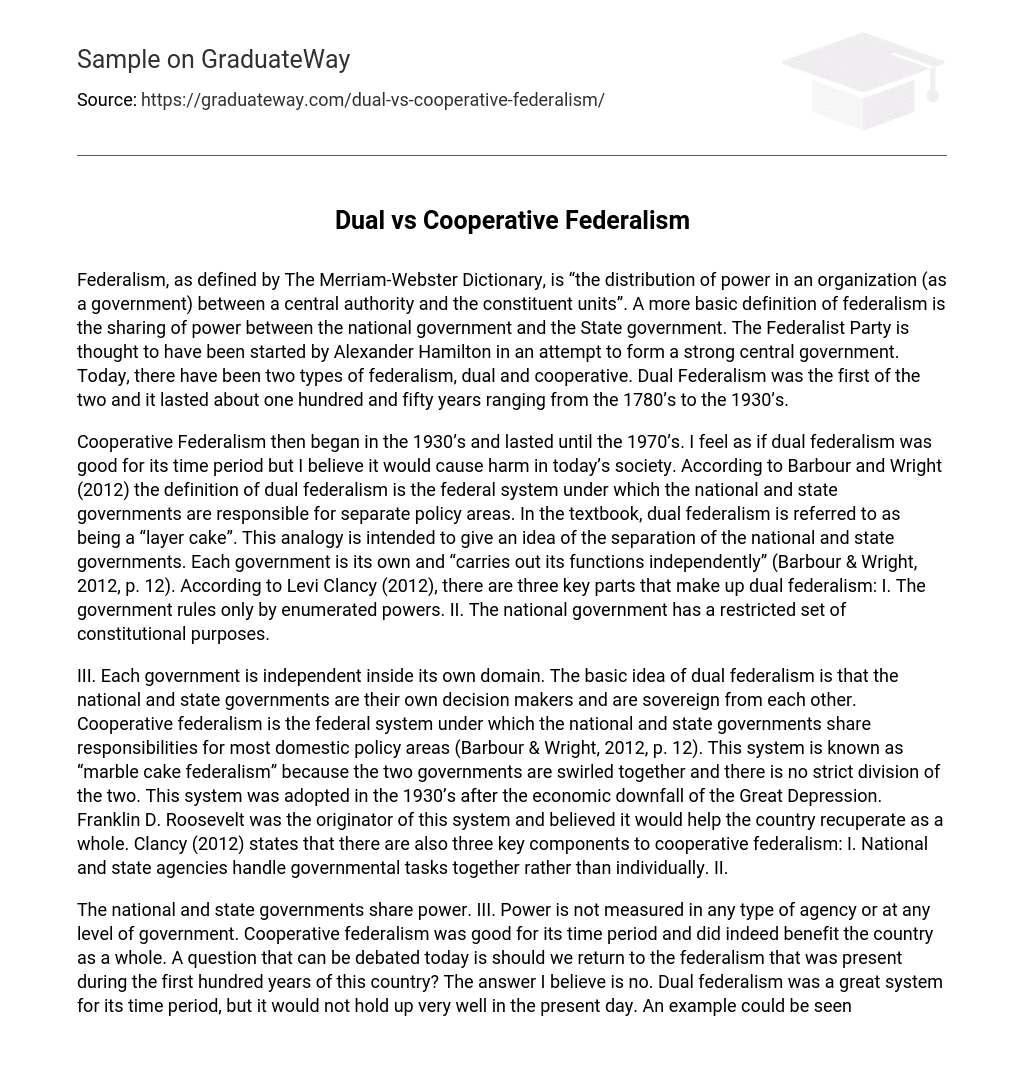The Merriam-Webster Dictionary defines federalism as the distribution of power in an organization, like a government, between a central authority and constituent units. It can also be described as the sharing of power between the national government and state governments. Alexander Hamilton is acknowledged for establishing the Federalist Party with the aim of creating a powerful central government. At present, there are two forms of federalism: dual federalism and cooperative federalism. Dual Federalism was the original type that endured from the 1780s until the 1930s, encompassing around 150 years.
Cooperative Federalism, which emerged in the 1930s and persisted until the 1970s, replaced dual federalism. While dual federalism had its advantages at that time, it is not suitable for today’s society. According to Barbour and Wright (2012), dual federalism can be defined as a system where the national and state governments have distinct responsibilities for policy areas. In their textbook, they compare dual federalism to a “layer cake” to illustrate the separation between the national and state governments. Each government operates independently and carries out its own functions (Barbour & Wright, 2012, p. 12). Levi Clancy (2012) identifies three key aspects of dual federalism: I. The government only exercises enumerated powers II. The national government has a limited set of constitutional purposes.
III. Dual federalism recognizes the autonomy of each government within its own jurisdiction. In this system, the national and state governments are separate decision-makers with their own sovereignty. On the other hand, cooperative federalism involves sharing responsibilities for most domestic policy areas between the national and state governments (Barbour & Wright, 2012, p.12). This approach, also known as “marble cake federalism,” integrates the two governments without a strict division between them. It was implemented during the Great Depression in response to economic adversity and was introduced by Franklin D. Roosevelt to aid in the country’s recovery. Clancy (2012) also highlights three important elements of cooperative federalism: I. Collaboration between national and state agencies instead of working separately. II.
Both the national and state governments hold power. While cooperative federalism has been advantageous nationwide, there is an ongoing debate about returning to traditional federalism. In my view, this is needless. Dual federalism fulfilled its role in the past; however, its relevance today remains uncertain, particularly given the country’s size.
When dual federalism was put into action, it aimed to maintain the distinctiveness of the states in comparison to the national government, thus preventing a governing system similar to England’s. Currently, giving states such significant authority could lead to a struggle for power and states asserting their independence as separate “countries” within the nation. This situation would inevitably result in conflict and potentially bring about the downfall of the nation. Therefore, I strongly support dividing powers between the national and state governments as the most appropriate structure for this country.
References
Barbour, C., & Wright, G. C. (2012). Keeping the republic: Power and citizenship in American politics, the essentials. (5th ed.). Washington, DC: CQ Press.
Charles, M. (2012, January 19). An Encyclopedia Britannica company Merriam-Webster. Retrieved from http://www.merriam-webster.com/dictionary/federalism.
Clancy, L. (2012, September 17). Dual federalism & cooperative federalism. Retrieved from http://studentreader.com/dual-federalism-cooperative-federalism/.





